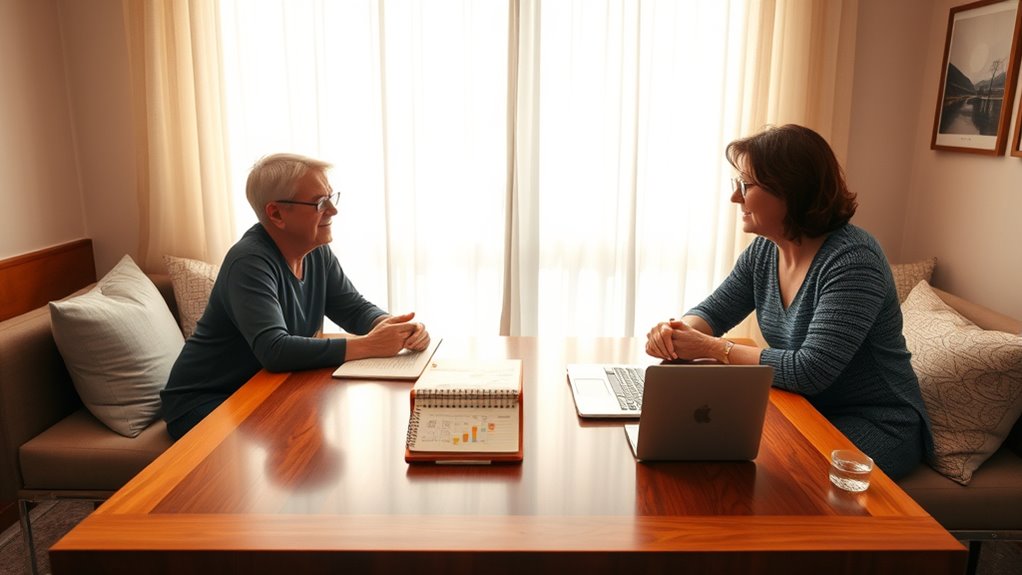To work effectively with your therapist on BPD, build trust by being honest, consistent, and open about your feelings and concerns. Communicate your symptoms clearly and share your goals and setbacks openly. Stay committed to your treatment, practice skills regularly, and track your progress to notice patterns and improvements. Address any emotional or interpersonal challenges openly, and understand that setbacks are normal. Keep these strategies in mind to foster a strong, collaborative relationship that supports your healing journey.
Key Takeaways
- Build a trusting, non-judgmental relationship by actively sharing experiences and providing honest feedback.
- Set collaborative, realistic goals and communicate openly about progress, setbacks, and concerns.
- Practice consistency in attendance and skill application to reinforce progress and demonstrate commitment.
- Share emotional responses and symptoms honestly to tailor therapy techniques and address underlying issues.
- Develop a personalized relapse prevention plan and track progress to sustain long-term recovery.
Building Trust and Establishing a Therapeutic Alliance

Have you ever wondered how to create a strong foundation for therapy with someone who has BPD? Building trust is essential, especially since emotional instability and fear of abandonment can make forming connections challenging. Start by being consistent and reliable; show up on time and follow through on promises. Listen actively and validate their feelings without judgment, demonstrating that you understand their experiences. Be patient as trust develops gradually—avoid rushing or pressuring them. Create a safe space where they feel comfortable sharing without fear of criticism or rejection. Over time, this consistent support fosters a secure therapeutic alliance, which is vital for effective treatment. Remember, trust isn’t built overnight, but your dedication can make a significant difference.
Understanding Your Treatment Options and Goals

Understanding your treatment options helps you choose therapies like Dialectical Behavior Therapy, Mentalization-Based Treatment, or Schema Therapy that target specific BPD symptoms. Setting realistic goals with your therapist keeps your progress measurable and manageable, especially since improvement varies across symptom domains. Be prepared to face challenges like dropout or slow progress, and work with your therapist to adjust your plan as needed.
Therapy Modalities Overview
Choosing the right therapy modality is essential for effectively managing BPD symptoms and achieving your treatment goals. You have several options, each with unique approaches and focuses. Dialectical Behavior Therapy (DBT) emphasizes emotional regulation and mindfulness, helping you handle intense feelings and impulsivity. Mentalization-Based Treatment (MBT) improves your ability to understand your own and others’ mental states, fostering healthier relationships. Schema Therapy targets deep-seated patterns rooted in early experiences, promoting lasting change. Treatment-as-usual may include general counseling, but it’s usually less effective for BPD. Your therapist will help you select the best modality based on your specific symptoms, needs, and preferences, ensuring your path toward recovery is tailored, effective, and sustainable.
Setting Realistic Goals
Setting realistic goals is a essential step in your treatment journey because it helps you focus on achievable outcomes and stay motivated. Clear, practical goals give you direction and prevent frustration from unrealistic expectations. Work with your therapist to identify specific areas you want to improve, such as emotional regulation, interpersonal skills, or managing impulsivity. Remember, progress takes time, and setbacks are normal. Avoid aiming for perfection; instead, aim for steady growth. Break down larger goals into smaller, manageable steps to track your progress. Setting realistic goals also helps you stay committed and engaged in therapy, making the process feel more manageable and less overwhelming. Celebrate small successes—they’re essential milestones on your path to recovery.
Addressing Treatment Challenges
Exploring the treatment landscape for BPD can be challenging, but being informed about your options helps you set realistic goals and make effective choices. You should understand that therapies like Schema Therapy, MBT, and adapted DBT generally produce better results than treatment-as-usual, especially in reducing symptoms like emotional instability. However, improvements in impulsivity and suicidality can be limited, and treatment effectiveness may decline with age. Men with BPD often face higher dropout rates and less access to tailored therapies. To address these challenges, work with your therapist to set specific, measurable goals for different symptom domains, and be open about difficulties or setbacks. Staying informed and proactive helps you navigate obstacles and remain committed to your recovery journey.
Communicating Openly About Your Symptoms and Concerns

To get the most from therapy, you need to share your symptoms regularly and honestly. Clearly voicing your concerns helps your therapist understand what’s working and what’s not. Don’t hold back your emotional responses—expressing them fully lets your therapist support you more effectively.
Share Your Symptoms Regularly
Sharing your symptoms openly with your therapist is a vital step toward effective treatment. When you communicate honestly about how you’re feeling, what triggers you, and any new or worsening symptoms, it helps your therapist understand your current state. This ongoing honesty allows your therapist to adjust strategies and interventions to better suit your needs. Don’t hold back or minimize your experiences; even seemingly minor details can be important. Regularly sharing updates ensures that your treatment remains relevant and responsive. Remember, your therapist is there to support you and needs your input to help you manage BPD more effectively. Building this open dialogue fosters trust and helps you stay engaged in your recovery process.
Voice Treatment Concerns Clearly
Being open about your symptoms and concerns is essential for effective therapy, especially when managing BPD. Clear communication helps your therapist understand your experiences and tailor treatment to your needs. Don’t hesitate to voice doubts or discomfort about specific techniques or progress. If something feels wrong or confusing, say so. Sharing your fears about stigma, emotional triggers, or setbacks allows your therapist to address these issues directly. Be specific about what symptoms bother you most or feel unresolved. This honesty builds trust and ensures you get the support you need. Remember, therapy works best when you actively participate and communicate openly. Your therapist is there to listen and help you navigate your challenges—so speak up clearly and confidently.
Express Emotional Responses Fully
Expressing your emotional responses fully is essential for effective communication with your therapist. When you share your feelings honestly, you help them understand your experience better. This openness allows your therapist to tailor strategies that meet your needs and address underlying issues. Sometimes, you might feel hesitant or discomforted, but pushing through helps build trust and clarity. Remember, your emotions are valid, and sharing them doesn’t mean you’re weak. Use this table to see how different responses influence therapy outcomes:
| Response Type | Impact on Therapy |
|---|---|
| Suppression | Hinders understanding; stalls progress |
| Over-sharing | Can overwhelm; reduce focus on core issues |
| Honest sharing | Enhances trust; fosters targeted support |
| Avoidance | Limits insight; prolongs challenges |
| Emotional honesty | Builds connection; promotes growth |
Being genuine encourages meaningful change.
Staying Committed and Managing Dropout Risks

Staying committed to therapy can be challenging for individuals with BPD, especially given the high dropout rates associated with the disorder. You might feel overwhelmed, frustrated, or uncertain about progress. To manage this, set clear, realistic goals and communicate openly with your therapist about your concerns. Recognize that setbacks are normal and part of the process, so don’t be discouraged if motivation dips. Building a strong therapeutic relationship can also boost your commitment; trust and rapport make it easier to stay engaged. Remember, consistency is key—attending sessions regularly and practicing skills between appointments help solidify progress. If you consider dropping out, discuss your reasons with your therapist to find solutions together, ensuring you stay on track for long-term recovery.
Tracking Your Progress and Adjusting Strategies

To effectively manage your progress in therapy, tracking your symptoms and responses can make a significant difference. Keep a journal or use apps to record daily mood swings, impulsive behaviors, and interpersonal challenges. This helps you identify patterns and triggers, giving your therapist valuable insights. Regularly review your entries to gauge improvements or setbacks over time. If certain strategies aren’t working, don’t hesitate to discuss adjustments with your therapist. Flexibility is key—what works at one stage may need refining later. Celebrate small wins and be honest about ongoing struggles. By actively monitoring your journey, you stay engaged and empowered, making it easier to tailor strategies that fit your evolving needs and sustain your progress.
Addressing Emotional and Interpersonal Challenges

Managing emotional and interpersonal challenges in therapy requires you to develop awareness of your emotional responses and relationship patterns. Recognize how your feelings can fluctuate rapidly and influence your interactions. Share these insights with your therapist to identify triggers and recurring patterns. Practice mindfulness to stay present during emotional upheavals, helping you respond rather than react impulsively. Work on building skills like emotional regulation and effective communication. Your therapist can guide you through exercises to improve understanding of your needs and boundaries. Consistently applying these strategies helps you manage intense emotions and navigate relationships more healthily. Remember, addressing these challenges is a gradual process that benefits from honesty, patience, and a willingness to explore uncomfortable feelings. Your effort is key to meaningful progress.
Recognizing and Overcoming Stigma and Gender Biases

Addressing emotional and interpersonal challenges often involves uncovering patterns that may be influenced by external factors like societal perceptions. Stigma around mental health and biases about gender can make it difficult for you to seek help or fully engage in therapy. Men, in particular, might face stereotypes that label them as less emotionally capable or less deserving of support, leading to higher dropout rates and treatment resistance. Recognizing these biases is the first step toward overcoming them. Talk openly with your therapist about any feelings of shame or judgment you experience. Remember, your struggles are valid regardless of societal stereotypes. Challenging these external perceptions helps you build confidence and ensures you receive the support you need to work through BPD effectively.
Preparing for Long-Term Recovery and Relapse Prevention

Long-term recovery from BPD requires ongoing effort and proactive strategies to prevent relapse. You should work with your therapist to develop a personalized relapse prevention plan that includes identifying early warning signs of setbacks and implementing coping skills quickly. Regularly practicing emotional regulation techniques, such as mindfulness or grounding exercises, helps maintain stability. Staying committed to therapy and skill development is essential, even when you’re feeling well. Building a strong support system outside of therapy provides additional resilience. Keep track of your progress and setbacks to recognize patterns and adjust your approach as needed. Remember, setbacks don’t mean failure—they’re part of the recovery journey. Consistent effort, self-awareness, and collaboration with your therapist are key to sustaining improvements and reducing the risk of relapse.
Collaborating With Your Therapist for Personalized Care

Working closely with your therapist is essential for creating a personalized treatment plan that fits your unique needs and goals. You should openly communicate your experiences, challenges, and progress to help your therapist understand what works best for you. Be proactive in discussing your preferences, concerns, and any setbacks you face. Collaborate on setting realistic, measurable goals to track your improvements over time. Your therapist can adapt techniques and focus areas based on your feedback, ensuring treatment remains relevant and effective. Remember, therapy is a partnership—you play an active role in shaping your recovery. By staying engaged and honest, you maximize the benefits of personalized care, making your journey toward managing BPD more targeted and successful.
Frequently Asked Questions
How Can I Improve Emotional Regulation Between Therapy Sessions?
To improve emotional regulation between sessions, practice the skills your therapist teaches, like mindfulness or grounding techniques. When you notice intense feelings, take deep breaths, focus on your senses, or use distraction strategies to calm down. Keep a journal to track your emotions and triggers, so you become more aware and prepared. Consistently applying these tools helps you manage emotions better, making daily life more stable and less overwhelming.
What Are Signs I Might Be Experiencing a Relapse?
You might notice your symptoms spiraling out of control faster than a rollercoaster if you’re experiencing a relapse. Signs include intense emotional swings, impulsive behaviors, increased feelings of emptiness, or thoughts of self-harm and suicidality. You could also feel more disconnected from reality or notice relationship conflicts worsening. Trust your instincts—if these signs appear, reach out to your therapist promptly to get support before things escalate further.
How Do I Address Gender Biases Affecting My Treatment?
You can address gender biases by openly discussing your concerns with your therapist and advocating for your needs. Ask questions about treatment options tailored to your experience and challenge stereotypes that might influence your care. Seek a therapist who recognizes and respects gender differences in BPD treatment, and consider joining support groups for men or diverse populations to share experiences and gain insights. Your voice matters in shaping effective, respectful treatment.
What Specific Strategies Help Reduce High Dropout Risk?
If you’re at high risk of dropping out, try setting small, achievable goals with your therapist to keep you motivated. For example, imagine a client who commits to attending each session and practicing a new skill weekly. This accountability helps you stay engaged. Regularly sharing your concerns about therapy’s pace or approach also fosters trust, making it easier to stay committed and motivated throughout your treatment.
How Can I Communicate My Treatment Preferences Effectively?
You should be open and honest about your treatment preferences from the start. Clearly express what works for you, such as specific techniques or goals, and share any concerns or past experiences. Listen actively to your therapist’s suggestions, but don’t hesitate to ask questions or suggest alternatives. Remember, your input is crucial to tailoring the therapy to your needs, and a collaborative approach fosters better engagement and outcomes.
Conclusion
Remember, your therapy journey is like sailing a ship through unpredictable waters. Building trust and staying committed helps you navigate storms and find calmer seas. By openly sharing your feelings and working closely with your therapist, you’re steering toward healing and growth. Every step you take is a compass pointing closer to stability. Keep your eyes on the horizon—your brighter future is waiting just beyond the waves.









